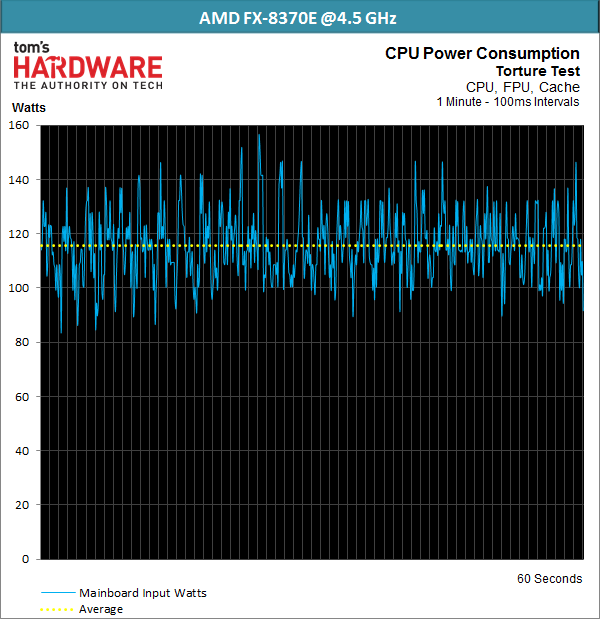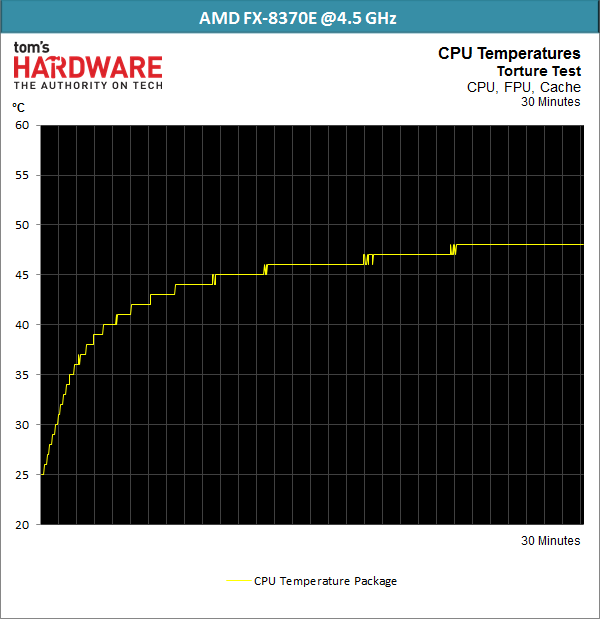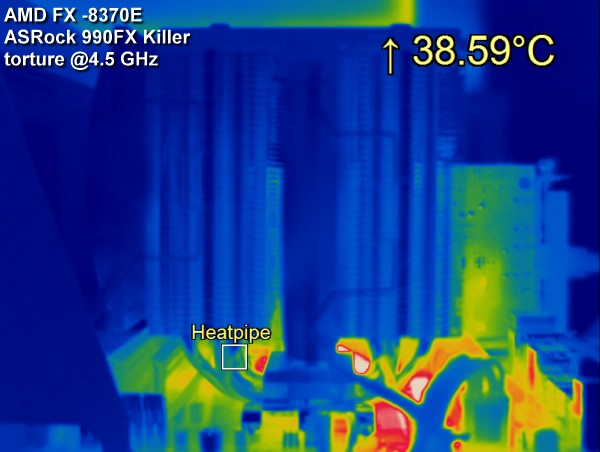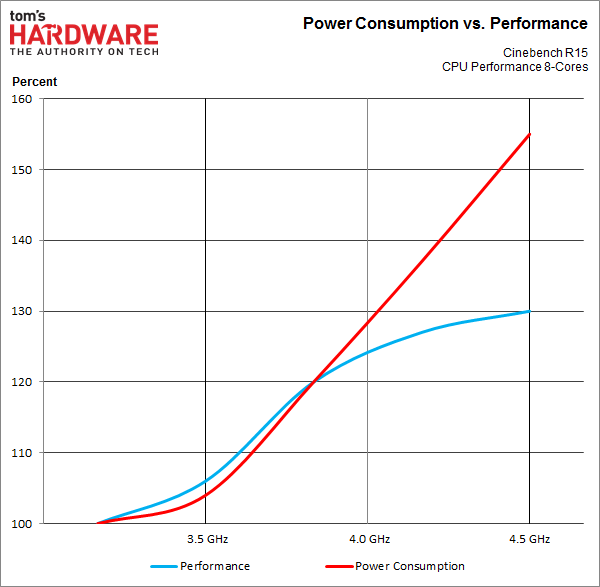AMD FX-8370E Review: Pulling The Handbrake For More Efficiency
Going more slowly is more efficient. That’s what AMD must have thought when they designed its new FX-8370E processor, thus closing a gap in the company's line-up. We evaluate whether this CPU is really more efficient and what happens when we overclock it.
Power Consumption: Overclocking To 4.5 GHz
AMD FX-8370E at 4.5 GHz
For some reason, everyone seems to want to hit a nice, round 4.5 GHz when they overclock. We're not going to be the exception, even though it might not be an efficient approach to tuning AMD's Vishera core. Really, this CPU can go higher. We even managed 5 GHz long enough to boot into Windows. That required an unsafe 1.5 V though, which is unreasonable for running benchmarks.
Core Voltage
The core voltage at 4.5 GHz was set to 1.315 V in the BIOS, resulting in an actual reading of 1.26 V. This is already quite high, even though it’s still a lot more manageable than 1.5 V.
Power Consumption
At 116 W for the CPU and VRM combined, AMD's FX-8370E is still doing well, especially since the CPU’s contribution is probably under 100 W.
It's annoying that the motherboard and its voltage regulation circuit hit almost 80 degrees Celsius, though. If massive overclocking is your goal, then a more efficient platform would help.
Temperatures
Get Tom's Hardware's best news and in-depth reviews, straight to your inbox.
In light of the previous findings, especially the relatively moderate power consumption, a CPU package temperature of 47 degrees Celsius isn't surprising. The processor's heat spreader registers 53 degrees Celsius according to the sensor under it, which isn’t much higher.
The infrared snapshot shows us that a big aftermarket cooler is capable of handling the FX processor's thermal load. Its two fans remain barely audible.
Efficiency
Does it make sense to run at a higher clock rate, trading better performance for increased power consumption? The answer isn’t clear-cut. We do see that the CPU speeds up while essentially consuming the same amount of power when it’s overclocked to 3.5 GHz. This is achieved with mostly untouched BIOS settings and a manual Vcore configured to match AMD's stock reading. Then there's the sweet spot (the point beyond which efficiency starts to decrease). We calculate this to land right around 3.8 GHz. And once you crest 4.2 GHz or so, overclocking AMD's FX-8370E probably doesn't make much sense. It mostly wastes electricity.
Again, if you're gunning for the sweet spot, it's right around 3.8 GHz. That's where you'll get sub-90 W power consumption and respectable performance. If you care more about benchmark results than your power bill, consider calling it a day around 4.2 GHz. Yes 4.5 GHz and higher is possible, but at a certain point you're going to spend too much on a beefy motherboard and high-end cooler, negating the value of overclocking outright.
Current page: Power Consumption: Overclocking To 4.5 GHz
Prev Page Power Consumption: Overclocking To 3.5 And 4.0 GHz Next Page Gaming: 4.2 GHz Is A Sensible Ceiling
Igor Wallossek wrote a wide variety of hardware articles for Tom's Hardware, with a strong focus on technical analysis and in-depth reviews. His contributions have spanned a broad spectrum of PC components, including GPUs, CPUs, workstations, and PC builds. His insightful articles provide readers with detailed knowledge to make informed decisions in the ever-evolving tech landscape
-
MeteorsRaining The price point is a deal breaker. Its a fairly good CPU for AMD builders, but can't give it the tag of budget builder, you get i5 non-K in that price. Its moving into a higher (cost wise) territory with weak arsenal.Reply -
The_Doc How to start a benchmark review? But of course, let's show how powerful is AMD in single core!Reply
I think we all get it Vishera isn't exactly wonderful in single core operations, but:
A) I have yet to see any software which requires A LOT of single core power, it's 2014, if something is still single-core, it probably doesn't need all that power or il old enough to make even Vishera good at it.
B) You are comparing a 2012 architecture to a 4790K, It's like comparing Pentium 4 to a Pentium G3258.
-
husker Article quote: "However, it's probable that AMD sent us a sample chosen specifically for this purpose. Plus, there is almost certainly variance from one -8370E to the next. And so it's hard to know if the FX-8370E is actually better."Reply
If you pre-suppose that your sample is tainted why bother to do the testing and the article in the first place. Perhaps this is a case where your should purchase the product of the shelf in order to better serve your readers. -
1991ATServerTower I would have liked to see a power consumption chart of the following cpus all clocked to 3.8GHz.Reply
8150, 8320, 8230e, 8350, 8370e.
That would demonstrate the improvements of Vishera over Bulldozer, as well as any improvements offered by binning. -
oxxfatelostxxo "If you pre-suppose that your sample is tainted why bother to do the testing and the article in the first place. Perhaps this is a case where your should purchase the product of the shelf in order to better serve your readers."Reply
1) almost every vendor does this, cpus, graphics, ect..
2) the chip they received is exactly what you get when you buy it off the shelf, however every cpu/gpu ect varies by a small amount. The vendors simply make sure that review sites get the top end of that group. In all honesty we are probably talking 3% performance from the majority at most. -
ShadyHamster Any chance the older 8320/50 could be tested at the same voltages and clock speeds to better compare power usage?Reply
My 8320 will happily run 3.5/3.6ghz @ 1.15v as long as turbo core is disabled. -
m32 I've had a few 8350's that needed 1.41-1.45v for 4.5. These E models needs less voltage compared to the originals when dealing with "moderate" overclocks.Reply
I will probably get the 8320E for my office computer during Black Friday. $140 is the price right now but I prefer $125 or less for an AMD CPU. -
Chris Droste for all we know a nice, process-refined 8350 is the exact same chip under the hood, they just clocked it down and gave it a new name. someone wake me when AMD starts to innovate desktop CPUs again.Reply -
hmp_goose While it's nice to see a sweet spot staked out for the OC, and really nice to hear about how much smaller the heatsink can be, what I'd like to see if the E OCs cooler/ less wattage then the two non-Es. I like to think a 8350 is better then a 8320 if you care about power consumption at all, and want to see if the trend continues with the 8370 & 8370E …Reply -
RedJaron Reply
Precisely, which goes right along with what Igor said:14227111 said:The price point is a deal breaker. Its a fairly good CPU for AMD builders, but can't give it the tag of budget builder, you get i5 non-K in that price. Its moving into a higher (cost wise) territory with weak arsenal.
Yes 4.5 GHz and higher is possible, but at a certain point you're going to spend too much on a beefy motherboard and high-end cooler, negating the value of overclocking outright.
Far too many people forget the whole cost of OCing a chip. Sure, a 4.5 83XX can slightly beat a stock i5, but at what cost? The 6300 is a far more compelling CPU for tweakers. If you're lucky on a few sales, you can get the chip, cooler, and mboard for the same $200. And as pointed out here, unless you're pairing it with a top-shelf GPU, you won't see any gaming benefits with a pricier platform.
This is AMD's latest offering. The Haswell refresh is Intel's latest offering. Whatever the products' pedigrees, why shouldn't the two latest SKUs be compared?14227240 said:B) You are comparing a 2012 architecture to a 4790K, It's like comparing Pentium 4 to a Pentium G3258.




